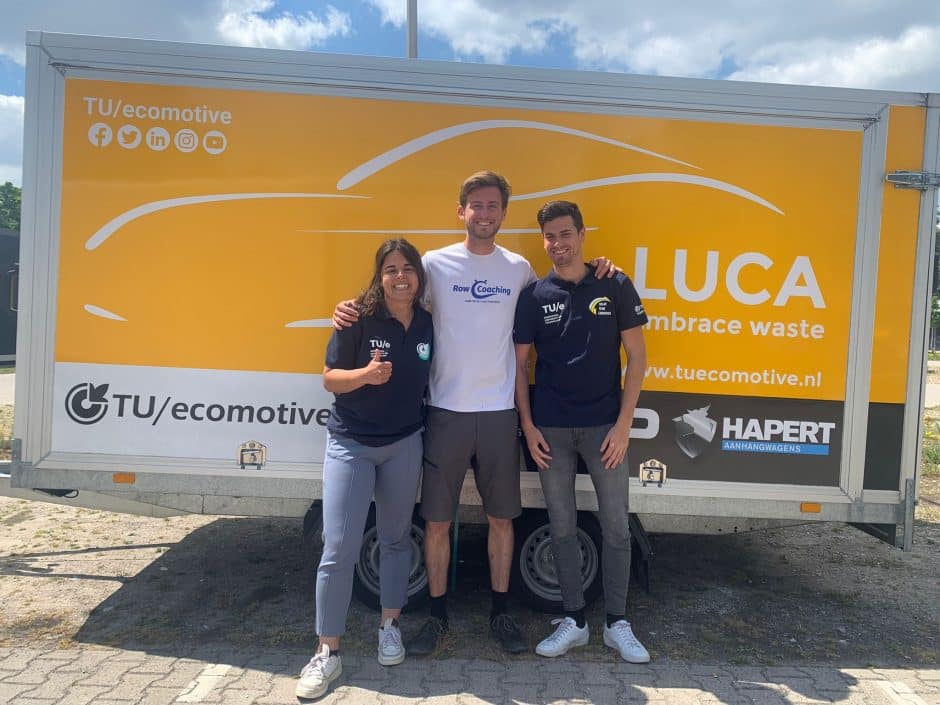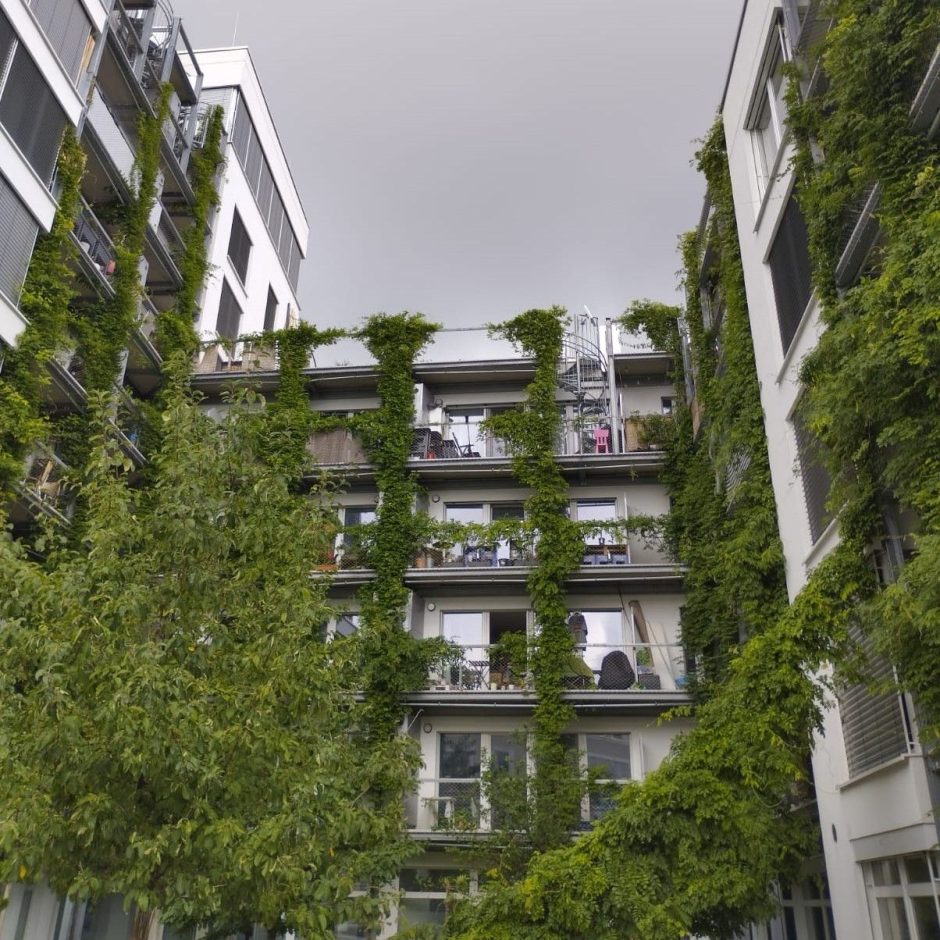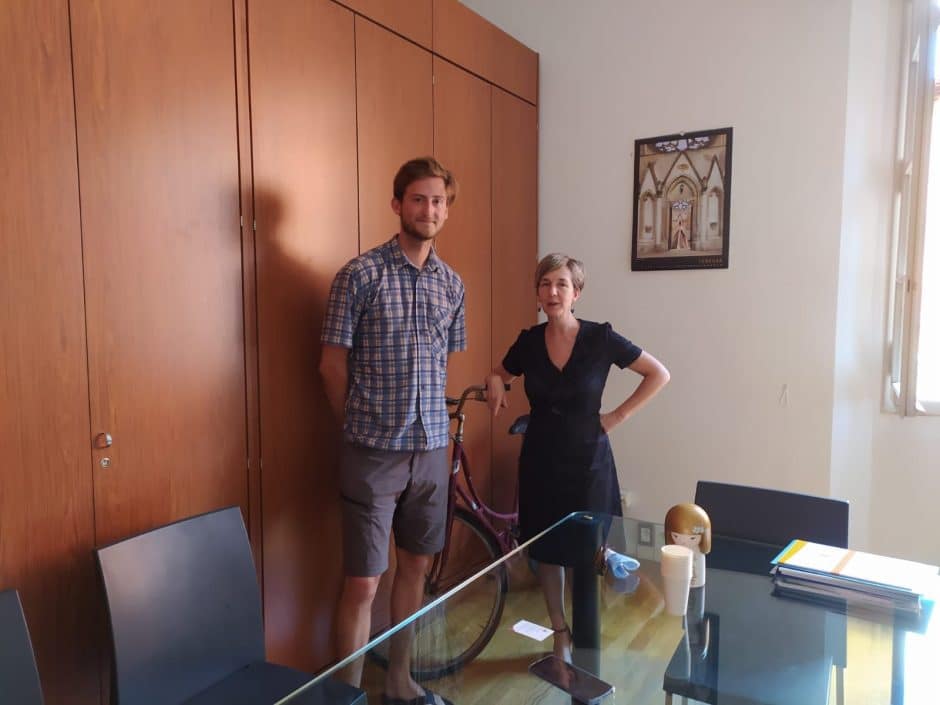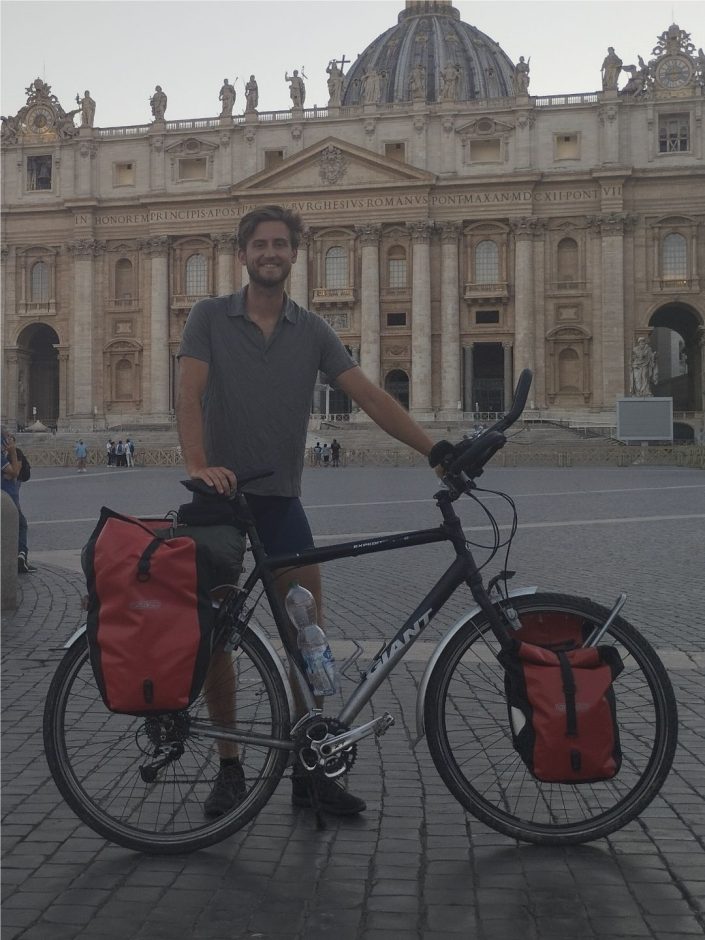A Climate Leadership Journey student cycled through NetZeroCities: From Delft to Rome, here’s what he learned along the way
Opinion
10 Aug 2022
In the lead up to the 2022 Climate Leadership Journey in Milan, Sietse de Vilder embarked upon a cycling trip to Rome from his home in Delft. Along the way, he cycled through through member cities of NetZeroCities—an initiative led by EIT Climate-KIC helping cities to achieve net-zero carbon emissions by 2030—and met up with local climate leaders. This article is a lightly-edited compilation of de Vilder’s LinkedIn posts, which chronicled his journey.
The journey begins
Today I started an exciting journey from Delft to Rome on my bike. Along this journey I will pass through several cities which are part of the European Union’s mission: ‘100 Climate Neutral Cities by 2030’. This mission aims to pave the way towards a climate neutral and climate resilient Europe. Cities are the cornerstone to this transition as they consume over 65 per cent of the world’s energy and account for more than 70 per cent of global CO2 emissions. NetZeroCities (NZC) is a project coordinated by EIT Climate-KIC that will help these cities overcome the current structural, constitutional and cultural barriers they face to reach this mission.
I am reaching out to city officials and NZC partners since I would love to learn more about this exciting project.
After the cycling trip I will participate in a two-week summer school in Milan, as part of the Climate Leadership Journey. Participating in this programme gives me the unique opportunity to meet and share knowledge with students and entrepreneurs from across Europe that have a common goal of tackling climate change. I hope to share some interesting insights I gained from the city officials and NZC partners with my fellow participants!
Eindhoven
Last week I cycled through Technische Universiteit Eindhoven’s campus hoping to find anyone that could link me to the right people involved in the ambitious target that Eindhoven has set to become climate neutral by 2030. By coincidence I stumbled upon Solar Team Eindhoven, who were so kind to invite me to their workplace and show me around.
Solar Team Eindhoven is an ambitious team of 22 students from the Eindhoven University of Technology that want to inspire the current market and society by creating innovative, energy-efficient solar vehicles. Their latest solar-powered vehicle is the Stella Vita, which they call their ‘self-sustaining house on wheels’. The solar panels on the rooftop can generate enough electricity to drive, shower, watch TV and make a cup of coffee while you’re at it.
Another very inspiring student team is TU/ecomotive. Their latest project is Luca: The world’s first plant and waste based modular car. The chassis of the car consists of a honeygrade structure made out of PET bottles, layered by flax which is strengthened by microplastics removed from the ocean. This year the team is developing a new concept car, aka CO2 neutral car, where they look at the full lifecycle of the vehicle. By implementing smart technologies, they try to reduce emissions as much as possible. For example, together with Cleantron cleantech batteries, they integrate battery packs that have a completely recyclable casing and a lithium battery that can be reused.

Eindhoven stands at the forefront of technological innovation with its University of Technology (TU/e), and as part of the technology region Brainport Eindhoven. It is not a surprise that the city dares to take on the challenge of becoming climate neutral by 2030. However, such a transition entails more than the integration of technological innovations.
To learn more about the social and institutional challenges the city faces, I talked with Judith Lammers, Programme Manager Climate, Energy and Environment and Thom Roozenbeek, Strategic Advisor, Public Affairs of the Gemeente Eindhoven.
It became clear to me that Eindhoven embodies collaboration on every domain. It has formed an alliance with Helmond, to become the only duo-city joining the Climate Neutral Cities Mission. Judith emphasises the importance of transparency and cooperation with the cities that have and have not been selected for this mission. For every tonne of CO2 counts, independent of where it has been emitted.
The same principle applies to collaboration and inclusivity of the citizens of Eindhoven and its companies. For a transition of this speed and scale, reaching quick and all-round agreements is an incredibly difficult task. However, the city has opened the dialogue with its citizens, companies and organisations before on complex themes to establish an agenda that reflects the city’s vision well. This might also be an effective tool for citizen participation in the climate neutrality mission!
On a larger scale, the transformation of a city implies the need for effective collaboration between the local government, national government and the European Commission. The involvement and decisiveness of the national government and in particular the Ministerie van Economische Zaken en Klimaat is crucial for a quick transition. This is a complex and time-consuming process, which currently forms a major institutional barrier for all the Dutch NetZeroCities.
Aachen
Just 100 kilometres away from Eindhoven, I cycled into the next NetZeroCities member city: Aachen. What big changes can we expect here within this decade? If you ask Philipp Noack, a political candidate of the local green party, BÜNDNIS 90/DIE GRÜNEN, climate activist and social economics student, a big transformation will occur in the urban mobility system.
Although electric cars show a promising role for mobility in the future, when it comes to climate neutrality, they are not going to solve the issue of traffic congestion within the inner ring of Aachen. For decades all mobility politics in Germany have prioritised cars. The increasing population density, pressure on public space and lack of an inclusive mobility system now call for a more holistic approach. Philipp envisions a city that prioritses good public transport systems and infrastructure for cyclists and pedestrians over facilitating the continuous growth of car transport.
He is hopeful about this development, since the new city mayor Sibylle Keupen has focussed on clean mobility by removing parking for more public space, walking and cycling infrastructure. However, these minor interventions have already resulted in major uprisings from car owners and more conservative politicians in the city council. According to Philipp, this is a social challenge where we must break through the persistent idea that cars should remain priority number one when it comes to urban transport.
This brings him to his central message: “We often tend to see the way to climate neutrality as a technical issue. However, it’s very much a social issue and this is always in relation with power. What we need to do is to build strong movements.”
Especially in a city like Aachen, with strong technical universities, technological development tends to be seen as the holy grail for complex issues such as climate change. However, it is social movement that can drive politics to integrate these technologies effectively in a more socially sustainable environment. This is why Philipp actively advocates for socially just climate policy.
Heidelberg
Some people don’t like it when you enter their office, unannounced while wearing flip flops and swimming shorts. Luckily for me, the municipality of Heidelberg did not bother and Mathieu Fuchs and Viktoria Reith, Department of Environmental Protection, Trade Supervision and Energy, even offered me some insights into Heidelberg’s climate neutrality mission.
I would like to share with you an exciting project that Heidelberg has been working on since 2008: Bahnstadt. The district is home to around 5,500 people and is one of the biggest operating carbon-neutral districts in the world. The municipality had all buildings constructed in accordance with passive-house standards, which ensures a very low heating and cooling energy demand. All energy demand is fully met by means of biomass (wood-chips) incineration and solar power. Furthermore, the district is filled with green roofs, green facades and a public park to reduce urban heat island effect and flood risks, and provide a better habitat for wildlife.

Mathieu mentioned the particular challenge NetZeroCities may face to make property investors comply with building standards such as the passive-house standards. To overcome this challenge, the municipality of Heidelberg founded their own development company rather than selling the area to the highest bidder. This enabled them to create strict sales contracts for investors in the area, requiring them to meet high building standards that are not yet required by law. The planners and architects have been supported by expertise from the Passive House Institute and actual compliance is verified through a robust quality assurance system, in each building phase.
With Bahnstadt, Heidelberg has set the tone for creating entire carbon-neutral districts. They are now working on creating their second carbon-neutral district: Patrick Henry Village, a former residential complex of the U.S. Army. Interestingly, the local industry will be connected to the central heating system of the district, to provide heating during the winter and extract energy from the district’s heat pumps during the summer.
Bologna
After cycling through the beautiful Alps, I carried on through the familiar flatland and unfamiliar heat of Emilia-Romagna towards the city of Bologna. At the municipal palace I had the honor of meeting Anna Lisa Boni, Deputy Mayor of Bologna, coordinator of the city’s ecological transition and former Secretary-General of Eurocities.

Anna Lisa points out that 70 per cent of Bologna’s emissions currently come from its buildings. Like all of Italy’s cities that are part of the Cities Mission, the built environment is filled with cultural heritage that’s well-protected by national legislation. A city centre where only red solar panels are allowed on structurally as well as spatially limited roof tops to preserve the city’s character, brings another dimension to the challenge of obtaining carbon-neutrality. That’s why the city has set its targets on creating energy-positive districts outside of the city centre while talking on the national level to make urban regulations more agile. Anna Lisa envisions self-sufficient energy communities, where different groups of citizens, companies and public authorities work together to produce enough energy to meet their collective needs. The city is now working on facilitating this with a focus on building energy savings and the implementation of distributed photovoltaic systems.
What impressed me the most was Anna Lisa’s dedication to involve every party, including citizens, in each phase of the city’s transformation. A climate citizens’ assembly has already been introduced as a body in the statute of the municipality. Starting in November 2022, randomly selected citizens will be informed about specific challenges, such as the conflict between preserving cultural heritage and sustainable development, and will be paid to join several meetings to change or propose policies.
One of EIT Climate-KIC’s partners, Fondazione Innovazione Urbana, presented me with several projects where citizens’ ideas, concerns and feedback are also integrated into the design phase, with a new tramline as a prime example. Another great example is Piazza Rossini, where they transformed parking spaces into a ‘temporary’ pedestrianised green space to qualitatively and quantitatively analyse the effects it had on citizens. Nowadays, the citizens cannot imagine these pedestrianised spaces turning back into asphalt parking lots so the city has decided to permanently pedestrianise the square.
Rome
 After cycling through the intense heat and drought in Tuscany, I had the honour of meeting the Director of the climate office and coordinator of the ecological transition of Rome, Edoardo Zanchini.
After cycling through the intense heat and drought in Tuscany, I had the honour of meeting the Director of the climate office and coordinator of the ecological transition of Rome, Edoardo Zanchini.
This entry is dedicated to addressing Rome’s biggest challenge of today: Waste management. Since its former landfill Malagrotta was forced to close in 2013 for failing to meet European environmental standards, garbage has piled up on the streets of the Italian capital. This even attracted wild boar, which can be found roaming the streets of the historic centre.
Obviously, the municipality was put under pressure to deal with the waste issue but the infrastructure simply wasn’t there. Consequently, the excess garbage is now transported to waste incinerators all over Italy and even to other European cities, including Rotterdam. These cities invest in a waste management system where local households are provided with heating and electricity, partially dependent on waste transported from other European countries.
Edoardo mentioned the targets that Rome has set to transition to a substantially circular waste management system within this decade: 30 recycling hubs should provide space for innovative reuse and recycling companies by 2026 and several recycling plants will be built for mostly recyclable waste flows (organic, plastic, etc.). A local waste incinerator to deal with excess waste, with the idea of integrating carbon capture and storage technology, is also part of the plan.
However, the controversial waste incinerator was part of a heated debate in the national government the day before I met Edoardo, which was one of the reasons for the departure of Prime Minister Mario Draghi and the collapse of the Italian government. This incident displays the fragility of national governments and again confronts me with the fact that although most of the technology and funding may already exist, the much needed collective decisiveness to tackle complex problems such as climate change is still lacking.
Related Goal
Goal 3: Accelerate clean urban mobility





 After cycling through the intense heat and drought in Tuscany, I had the honour of meeting the Director of the climate office and coordinator of the ecological transition of Rome, Edoardo Zanchini.
After cycling through the intense heat and drought in Tuscany, I had the honour of meeting the Director of the climate office and coordinator of the ecological transition of Rome, Edoardo Zanchini.